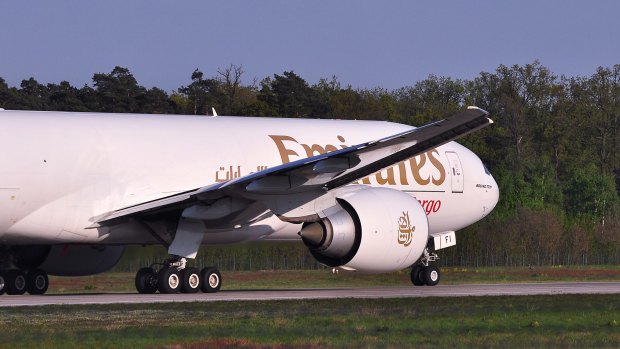This was published 5 years ago
Emirates windowless planes concept unveiled and new premium economy class
Window or aisle? The question might become irrelevant for Emirates passengers in the future after the airline's president suggested windowless passenger planes are the way of the future.
Emirates' new first class seat design uses video screens instead of windows.
The innovation could mean planes that have no windows, making the aircraft more structurally sound and potentially saving airlines money on fuel.

An Emirates cargo plane. The airline has indicated it would like to fly passenger planes with no windows.Credit: SHUTTERSTOCK
Emirates president Tim Clark told the BBC that windowless planes were the way of the future.
"Imagine now a fuselage as you're boarding with no windows, but when you get inside, there are windows," he said.
"Now you have one fuselage which has no structural weaknesses because of windows. The aircraft are lighter, the aircraft could fly faster, they'll burn far less fuel and fly higher."
While windowless planes might benefit airlines, there were potential issues with them for passengers.
One is safety, as passengers and crew need to be able to see outside in an emergency to check if it is safe to evacuate. Windows also allow crew to see potential issues with wings or engines for themselves, rather than relying on instruments.
Cargo planes typically already fly with no windows apart from those in the cockpit, but evacuating hundreds of passengers from these planes is obviously not an issue.
The latest idea from Emirates comes as the airline moves its focus from premium passengers to those in the cheap seats.
Emirates has been synonymous with luxury, offering premium-class passengers shower on board and a bar while cruising at 30,000 feet. Now the carrier wants to give some legroom for those flying further to the back.
The world's biggest long-haul airline outlined details of a new premium economy seat that it plans to help stem "leakage" of passengers who can't afford business, but want a more comfortable ride to competing airlines.
The carrier is introducing the seats on all of its new A380 and 777s from 2020 and plans to retrofit the seats onto some aircraft already in its fleet, Emirates President Tim Clark said. The Dubai-based carrier's A380s will have about 56 such seats in the front of the bottom deck of the aircraft while the 777s will have between 26 and 28.
Premium economy seats have arrived in recent years in carriers from Singapore Airlines to American Airlines as customers want more space and frills for a little extra, but aren't willing to fork out for business class. Emirates is taking steps to combat the encroachment of competitors on its routes, including the introduction of new low-cost carriers. The airline is also facing a more existential threat to its business model as planemakers Airbus SE and Boeing Co. work on new planes that will allow airlines including Qantas to fly some of the world's longest routes directly, bypassing big connecting hub airports.
Sleeperettes
"We're going to recognise that premium economy is something that is here to stay," Clark told reporters in Sydney on Monday. Emirates has "noticed much more leakage out of our mainstream passenger demand into carriers that have it."
The seats, which he described as "sleeperettes", will have a pitch of about 38 inches, up to 6 inches more than the current economy product, and will come with better service and food and a private toilet. Emirates is still in talks with various seat manufacturers to come up with a new design. There will also be a reduction in the number of seats in each row.
"The groundswell of opinion from the segments which are telling us that they are prepared to pay more for a more comfortable seat with more legroom with a degree of exclusivity," Clark said.
Champagne, Wine
As space in economy class becomes ever more constrained, airlines have devised a more spacious cabin product for passengers priced out of business class but determined to get more bang for their buck. Called "premium economy," this section of added frills between coach and business aims to address a widening gap that has emerged between those cabins-and to extract more money from passengers.
On almost every airline with premium economy, the biggest lure is increased seat pitch and width, typically along with nicer food and tableware, a larger entertainment screen, a fancier amenities kit, and occasionally, a more generous baggage allowance.
Qantas was one of the world's first airlines to introduce a premium economy class back in 2008, initially rolling out the seats on its Boeing 747 jumbos and later on to its other international aircraft.
In 2015, Singapore Air brought its premium-economy version, offering champagne, a broad selection of wines and food, a bigger TV and seats that were as much as 1 1/2 inches wider.
Clark ruled out the premium seats having hard-back shells as is the standard in business class which he said other carriers had scrapped because they were cannibalising their business-class sales. Fares for these seats won't be anything like business class pricing with the product being advertised as a supplement to economy, he said.
"We can see the take up, it's obvious to us that we need to do something," Clark said. "The difficulty is getting the mathematical point correct, you're trying to trade people up from economy, not down from business."
with Bloomberg
See also: Is premium economy worth the price?
Sign up for the Traveller newsletter
The latest travel news, tips and inspiration delivered to your inbox. Sign up now.